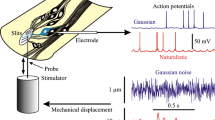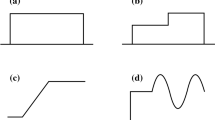Abstract
The power law of sensory adaptation was introduced more than 50 years ago. It is characterized by action potential adaptation that follows fractional powers of time or frequency, rather than exponential decays and corresponding frequency responses. Power law adaptation describes the responses of a range of vertebrate and invertebrate sensory receptors to deterministic stimuli, such as steps or sinusoids, and to random (white noise) stimulation. Hypotheses about the physical basis of power law adaptation have existed since its discovery. Its cause remains enigmatic, but the site of power law adaptation has been located in the conversion of receptor potentials into action potentials in some preparations. Here, we used pseudorandom noise stimulation and direct spectral estimation to show that simulations containing only two voltage activated currents can reproduce the power law adaptation in two types of spider mechanoreceptors. Identical simulations were previously used to explain the different responses of these two types of sensory neurons to step inputs. We conclude that power law adaptation results during action potential encoding by nonlinear combination of a small number of activation and inactivation processes with different exponential time constants.






Similar content being viewed by others
References
Barth F. G., Ein einzelnes Spaltsinnesorgan auf dem Spinnentarsus: seine Erregung in Abhängigkeit von den Parametern des Luftschallreizes. Z. Vergl. Physiol. 55: 407–449, 1971
Bendat J. S., A. G. Piersol, Engineering Applications of Correlation, Spectral Analysis. New York: John Wiley & Sons, 1980. pp. 1–302
Biederman-Thorson M., J. Thorson, Dynamics of excitation and inhibition in the light-adapted Limulus Eye in situ. J. Gen. Physiol. 58: 1–19, 1971
Bohnenberger J., Matched transfer characteristics of single units in a compound slit sense organ. J. Comp. Physiol. 142: 391–402, 1981
Brown M. C., R. B. Stein, Quantitative studies on the slowly adapting stretch receptor of the crayfish. Kybernetik 3: 175–185, 1966
Chapman K. M., R. S. Smith, A linear transfer function underlying impulse frequency modulation in a cockroach mechanoreceptor. Nature 197: 699–700, 1963
Cooley J. W., J. W. Tukey, An algorithm for the machine calculation of complex Fourier series. Math. Comput. 19: 297–301, 1965
Destexhe A., J. R. Huguenard, Nonlinear thermodynamic models of voltage-dependent currents. J. Comput. Neurosci. 9: 259–270, 2000
French A. S., Dynamic properties of the action potential encoder in an insect mechanosensory neuron. Biophys. J. 46: 285–289, 1984
French A. S., The receptor potential and adaptation in the cockroach tactile spine. J. Neurosci. 4: 2063–2068, 1984
French A. S., A. V. Holden, Alias-free sampling of neuronal spike trains. Kybernetik 8: 165–171, 1971
French A. S., A. V. Holden, R. B. Stein, The estimation of the frequency response function of a mechanoreceptor. Kybernetik 11: 15–23, 1972
French A. S., U. Höger, S. Sekizawa, P. H. Torkkeli, Frequency response functions and information capacities of paired spider mechanoreceptor neurons. Biol. Cybern. 85: 293–300, 2001
French A. S., I. Panek, P. H. Torkkeli, Shunting versus inactivation: simulation of GABAergic inhibition in spider mechanoreceptors suggests that either is sufficient. Neurosci. Res. 55: 189–196, 2006
French A. S., P. H. Torkkeli, The time course of sensory adaptation in the cockroach tactile spine. Neurosci. Lett. 178: 147–150, 1994
Gilboa G., R. Chen, N. Brenner, History-dependent multiple-time-scale dynamics in a single-neuron model. J. Neurosci. 25: 6479–6489, 2005
Gingl E., A. S. French, Active signal conduction through the sensory dendrite of a spider mechanoreceptor neuron. J. Neurosci. 23: 6096–6101, 2003
Gingl E., A. S. French, I. Panek, S. Meisner, P. H. Torkkeli, Dendritic excitability and localization of GABA-mediated inhibition in spider mechanoreceptor neurons. Eur. J. Neurosci. 20: 59–65, 2004
Hodgkin A. L., A. F. Huxley, A quantitative description of membrane current and its application to conduction and excitation in nerve. J. Physiol. 117: 500–544, 1952
Johnston D., S. M. S. Wu, Foundations of Cellular Neurophysiology. Cambridge, MA: MIT Press, 1995. pp. 1–676
Juusola M., A. S. French, The efficiency of sensory information coding by mechanoreceptor neurons. Neuron 18: 959–968, 1997
Landgren S., On the excitation mechanism of the carotid baroreceptors. Acta Physiol. Scand. 26: 1–34, 1952
Liebovitch L. S., J. Fischbarg, J. P. Koniarek, Ion channel kinetics: a model based on fractal scaling rather than multistate markov processes. Math. Biosci. 84: 37–68, 1987
Looft F. J., Linear systems analysis of cutaneous type I mechanoreceptors. IEEE Trans. Biomed. Eng. 37: 565–573, 1990
Looft F. J., Response of monkey glabrous skin mechanoreceptors to random-noise sequences: III. spectral analysis. Somatosens. Mot. Res. 13: 235–244, 1996
MacGregor R. J., Neural and Brain Modeling. San Diego, CA: Academic Press, 1987. pp. 1–643
Millhauser G. L., E. E. Salpeter, R. E. Oswald, Diffusion models of ion-channel gating and the origin of power-law distributions from single-channel recording. Proc. Natl. Acad. Sci. USA 85: 1503–1507, 1988
Sekizawa S.-i., A. S. French, U. Höger, P. H. Torkkeli, Voltage-activated potassium outward currents in two types of spider mechanoreceptor neurons. J. Neurophysiol. 81: 2937–2944, 1999
Sekizawa S.-i., A. S. French, P. H. Torkkeli, Low-voltage-activated calcium current does not regulate the firing behavior in paired mechanosensory neurons with different adaptation properties. J. Neurophysiol. 83: 746–753, 2000
Shannon C. E., W. Weaver, The Mathematical Theory of Communication. Urbana, Chicago and London: University of Illinois Press, 1949. pp. 1–117
Strout J., Conical: the computational neuroscience class library. Proc. 18th Annu. Conf. Cogn. Sci. Soc. 18:849, 1996.
Thorson J., M. Biederman-Thorson, Distributed relaxation processes in sensory adaptation. Science 183: 161–172, 1974
Toib A., V. Lyakhov, S. Marom, Interaction between duration of activity and time course of recovery from slow inactivation in mammalian brain Na+ channels. J. Neurosci. 18: 1893–1903, 1998
Torkkeli P. H., A. S. French, Simulation of different firing patterns in paired spider mechanoreceptor neurons: the role of Na+ channel inactivation. J. Neurophysiol. 87: 1363–1368, 2002
Torkkeli P. H., S. Sekizawa, A. S. French, Inactivation of voltage-activated Na+ currents contributes to different adaptation properties of paired mechanosensory neurons. J. Neurophysiol. 85: 1595–1602, 2001
Warland D. D., M. A. Landolfa, J. P. Miller, W. Bialek. Reading between the spikes in the cercal filiform hair receptors of the cricket. In: Analysis and Modeling of Neural Systems. edited by Eckman F., Kluwer Academic, Boston 1992, pp. 327–333
Watts R. E., A. S. French, Sensory transduction in dorsal cutaneous mechanoreceptors of the frog, Rana pipiens. J. Comp. Physiol. A 157: 657–665, 1985
Acknowledgment
Supported by grants from the Canadian Institutes of Health Research.
Author information
Authors and Affiliations
Corresponding author
Rights and permissions
About this article
Cite this article
French, A.S., Torkkeli, P.H. The Power Law of Sensory Adaptation: Simulation by a Model of Excitability in Spider Mechanoreceptor Neurons. Ann Biomed Eng 36, 153–161 (2008). https://doi.org/10.1007/s10439-007-9392-9
Received:
Accepted:
Published:
Issue Date:
DOI: https://doi.org/10.1007/s10439-007-9392-9




